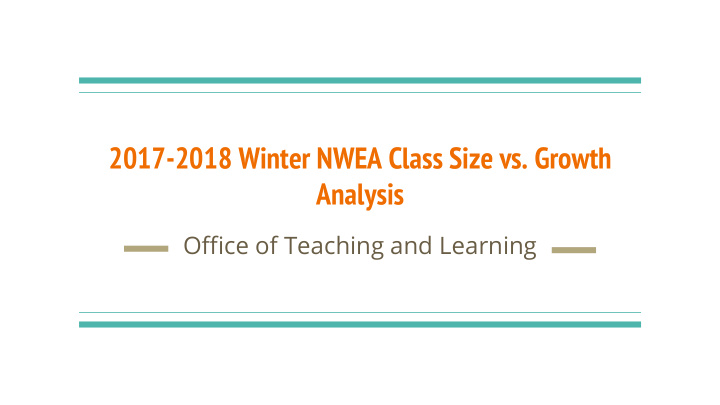



2017-2018 Winter NWEA Class Size vs. Growth Analysis Office of Teaching and Learning
Class Size and Research Smaller class sizes… ● Make it easier for teachers to build relationships ○ Provide more of an opportunity to get personalized attention ○ Support environments where students are more likely to be engaged/participate ○ Provide teachers with more flexibility to use different instructional approaches ○ Reduce the workload of teachers ○ What about the impact on academics? ● Primary - more of an impact ○ Intermediate and middle level - mixed bag ○ High School - no impact at all ○
Correlation ●
Correlation
Grades 3-8
Grades 3-5
Grades 6-8
Grades 3-8 - Class Size > 25
Grades 3-5 - Class Size > 25
Grades 6-8 - Class Size > 25
Sub-Group Correlations Sub-Group Correlation Sub-Group Correlation 3-8 ELA 0.010 6-8 Honors 0.145 3-8 Class Size >25 0.028 3-5 Class Size > 25 0.161 3-8 ELA Honors/Plus 0.049 6-8 On Grade Level Math 0.189 3-8 On Grade Level 0.071 3-8 Honors/Plus 0.200 ELA/Reading 6-8 Class Size > 25 0.071 3-8 Math Honors/Plus 0.200 3-8 On Grade Level 0.073 6-8 On Grade Level 0.212 ELA/Reading 6-8 All 0.135 3-5 On Grade Level ELA 0.212 3-5 Plus 0.081 3-5 On Grade Level 0.255 3-8 All 0.115 3-8 Math 0.271 6-8 On Grade Level 0.135 3-8 On Grade Level Math 0.276 3-5 All 0.138 3-5 On Grade Level Math 0.317
Analysis The impact of class size on student growth is directly in line with what the ● research suggests: Mixed results at the intermediate and middle level ○
Questions to Further Investigate How do teachers with a similar class size (large and small) and student ● population have significantly different results? What impact does larger class sizes have on the social-emotional ● well-being of our students in Quakertown?
Grades 3-8
Questions to Further Investigate How do teachers with a similar class size (large and small) and student ● population have significantly different results? What impact does larger class sizes have on the social-emotional ● well-being of our students in Quakertown? What supports can the building administrator, instructional coaches, or ● district level supervisors offer to those teachers who may be struggling to get students to meet expected growth?
Recommend
More recommend